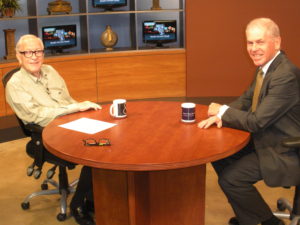When it’s time for the television interview, think in threes — and nine more tips
 Great news! You’ve been asked to be interviewed for a local broadcast news program. Even if this is your first time ever in front of a news camera and your immediate and primal reaction is nausea, you can prepare yourself to be a star when it’s time for your closeup:
Great news! You’ve been asked to be interviewed for a local broadcast news program. Even if this is your first time ever in front of a news camera and your immediate and primal reaction is nausea, you can prepare yourself to be a star when it’s time for your closeup:
1. Three things: Be prepared with three key points that you want to make. You should know the topic of the interview, and most reporters will give you a general idea of questions in advance, which is not the same as giving a list of questions in advance. News reporters and producers want spontaneity, and journalistic ethics also are involved. If the questions asked by the reporter don’t allow you to make your points, it’s OK to bridge from another point or to add, “I do want to make a couple of important points…” Editing may allow inclusion of your points, but only if you say them. Some reporters even ask after the final question, “Do you have anything to add?” But don’t count on it; make your points.
2. Eyes are the window: Look at the reporter who’s interviewing you, not the camera, unless you’re in the unusual circumstance of being interviewed via satellite or from a remote location. Keep a natural eye contact, avoiding looking down or to the side.
3. Prepare in advance: What questions are most likely to be asked? Brainstorm even off-the-wall possibilities, and practice with a friend or family member. If you have access to a video camera to review your performance with another person, even better.
4. Think in sound bites: These are the seven to 20 seconds usually allotted for an answer on the news. Don’t memorize material, but do have important facts and brief anecdotes in mind. Stories and examples bring more life. Ideally, an interview should be an educated, engaging conversation.
5. You’re the expert: You’ve been asked to appear due to your position and expertise, so you’ll very likely know the answer to any question thrown your way. If not, pause, take a breath, and say, “I don’t have that information now, but I can get an answer to you later today.” Chances are good this will be edited out of the interview.
6. Watch the news: Make some time to take notes on people who are interviewed on national news programs, morning and evening. Notice what makes people look and sound credible and convincing. Watch body language. You’ll observe that engaging interviewees often lean forward a bit and have an open body position, arms not crossed defensively but relaxed at their sides or, if seated, on their legs, overlapping a bit. Crossing legs at the ankle if seated will help improve posture. If standing, keep knees a bit flexed and one leg slightly ahead of the other to help prevent swaying from side to side – or fainting.
7. Read faces: When you’re looking at television interviews, notice facial expressions. It’s great to smile, if appropriate, but expressions should match the topics. If someone is citing cancer statistics, smiling isn’t congruent with their words and can be reminiscent of an insincere beauty pageant contestant.
8. It’s all about your expertise – and your outfit: Show up looking business-presentable (unless you’re an athlete or actor and have the uniform or costume for credibility). For women, that means a tailored blazer or shirt, avoiding tight knits or party looks. You want your clothes to not distract; you want them to say, “I’m a competent professional.” For men, a suit or blazer and shirt with tie are almost always the right choice, but if you don’t ever wear a tie, go with a tailored shirt and blazer. Solid colors are best for everyone. Avoid prints and stripes (except for ties). Avoid black and white, which don’t look as good on camera as color – it’s color TV, after all!
9. Makeup is your friend: Women should always wear makeup; outdoor light and the bright lights of the studio can have a bleaching effect. Men should consider powder to eliminate shine – including top of the head! Women should avoid shiny earrings or those that move and bracelets that jangle, which can be a distraction.
10. Finally, be confident: You know your material. Take a minute to be friendly with the reporter and treat the interview as an opportunity to bring important information to the reporter and viewers. You are the trustworthy, believable, knowledgeable representative of your organization, company or cause. Believe it, and your confidence will shine!

